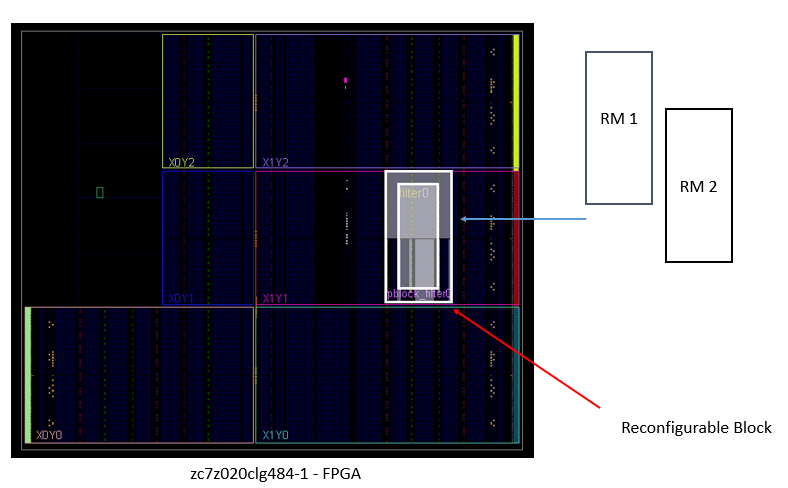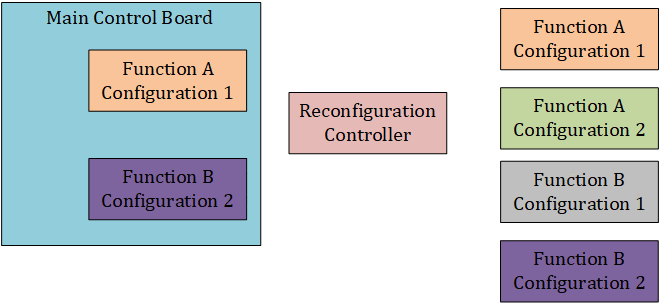Dynamic Partial Reconfiguration in FPGAs
 Muhammad Hamza Muneer
Muhammad Hamza Muneer
Partial Reconfiguration also called Dynamic function exchange (DFX) is used for the partial reconfiguration of the FPGA while the system is still running. This can be useful in situations where a system needs to be updated or modified without interrupting its operation.
This blog post will explore the concept of dynamic reconfiguration, its benefits, and its implementation in different domains.

Steps involved in Partial Reconfiguration
Module Identification: Identification of the modules that need to be exchanged on the fly
Design partitioning: The FPGA design is partitioned into smaller modules that can be independently reconfigured. Each module has its fixed coordinates in the FPGA floor plan.
Design partitioning: The FPGA design is partitioned into smaller modules that can be independently reconfigured.
Bitstream Generation: Bitstreams are generated separately for each reconfigurable module and a static portion of the design.
Reconfiguration controller: A controller is designed to manage the reconfiguration process, including selecting the appropriate bitstream and managing any required data transfer between modules.
Reconfiguration verification: Once the module has been reconfigured, it is verified to ensure that it is functioning correctly.
Use Cases of Partial Reconfiguration
Fault tolerance: Dynamic partial reconfiguration can be used to replace a faulty module within a design without disrupting the rest of the system's operation.
System optimization: Dynamic partial reconfiguration can be used to optimize the system's performance by modifying the design's configuration during runtime.
Power management: Dynamic partial reconfiguration can be used to dynamically turn off unused portions of the design to save power.
Multi-mode applications: Dynamic partial reconfiguration can be used to switch between different modes of operation, each with a different set of design parameters.
Testing and debugging: Dynamic partial reconfiguration can be used to isolate and test individual modules within a larger design without disrupting the rest of the system.
Adaptive systems: Dynamic partial reconfiguration can be used to adapt a system's design to changing environmental conditions or user requirements.
Applications of Partial Reconfiguration
Cyber-physical systems: Dynamic partial reconfiguration can be used in cyber-physical systems, such as autonomous vehicles or industrial control systems, to adapt to changing environments and ensure safety and reliability.
High-performance computing: Dynamic partial reconfiguration can optimize the performance of high-performance computing systems, such as clusters or grids, by dynamically adjusting the allocation of resources based on the workload.
Networking: Dynamic partial reconfiguration can improve the resilience and performance of networks, by allowing the network topology to be adapted to changing traffic patterns or failures.
Cloud computing: Dynamic partial reconfiguration is a key feature of cloud computing, as it allows the allocation of virtual resources to be adjusted based on the changing demands of the users.
Conclusion
In conclusion, Xilinx dynamic reconfiguration is a powerful feature that enables system designers to optimize performance, increase system availability, and create more versatile and adaptive systems. With a range of tools and techniques available to support this feature, dynamic reconfiguration is a key capability for any application that requires real-time performance and flexibility.
Feel free to reach out:
LinkedIn: linkedin.com/in/muhammad-hamza-muneer-39663..
e-Mail: hamzamuneer95@yahoo.com
Subscribe to my newsletter
Read articles from Muhammad Hamza Muneer directly inside your inbox. Subscribe to the newsletter, and don't miss out.
Written by
